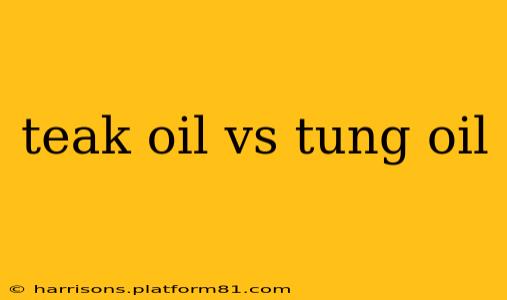Choosing the right oil for finishing your wood projects can feel overwhelming, especially when faced with options like teak oil and tung oil. Both are popular choices known for their protective and aesthetic qualities, but they have distinct differences that make them suitable for different applications. This comprehensive guide will break down the key distinctions between teak oil and tung oil, helping you make the informed decision for your next woodworking project.
What is Teak Oil?
Teak oil isn't actually extracted from teak trees. Instead, it's typically a blend of several oils, often including linseed oil, and sometimes other additives like solvents and UV inhibitors. It's marketed as "teak oil" because it's designed to mimic the look and feel of teak wood's natural oils, providing a rich, golden hue and enhancing the wood's grain. The primary function of teak oil is to penetrate the wood's surface, offering some water resistance and protection against the elements. However, it doesn't form a hard, durable film like a varnish or polyurethane.
What is Tung Oil?
Tung oil, on the other hand, is a true oil extracted from the seeds of the tung tree. It's a natural drying oil known for its durability and water-resistant properties. Pure tung oil penetrates deeply into the wood, polymerizing (hardening) to create a protective layer that's more resistant to scratches and abrasion than teak oil. While it offers excellent protection, it typically requires multiple coats to achieve a truly durable finish.
Teak Oil vs. Tung Oil: Key Differences
| Feature | Teak Oil | Tung Oil |
|---|---|---|
| Composition | Blend of oils (often linseed oil) & additives | 100% oil from tung tree seeds |
| Penetration | Moderate | Deep |
| Durability | Lower; less resistant to scratches and wear | Higher; more resistant to scratches and wear |
| Water Resistance | Moderate | Good |
| UV Resistance | Often contains UV inhibitors | Naturally low; needs UV protection |
| Drying Time | Relatively fast | Relatively slow |
| Finish Appearance | Typically a subtle sheen | Can range from matte to a slight sheen |
| Cost | Generally less expensive | Typically more expensive |
What are the uses of teak oil?
H2: What are the best applications for teak oil?
Teak oil is best suited for projects that require a quick-drying, easy-to-apply finish and don't necessitate extreme durability. It's often used on outdoor furniture, decking, and other projects exposed to the elements, but it requires more frequent reapplication compared to tung oil. It's also a good choice for interior projects where a natural look is desired, such as butcher blocks or wooden countertops that don't experience high wear and tear.
What are the best uses for tung oil?
H2: What is tung oil best used for?
Tung oil excels in applications demanding a hard-wearing, water-resistant finish. It's ideal for fine furniture, cutting boards, gunstocks, and other items that require exceptional protection and durability. Its slow drying time allows for better penetration and a more robust finish. The superior durability makes it a great choice for high-use items.
Which oil is better for outdoor use?
H2: Is tung oil or teak oil better for outdoor furniture?
While both can be used outdoors, tung oil offers better long-term protection against the elements due to its superior water resistance and durability. However, remember that both will require periodic maintenance and reapplication, especially in harsh climates. Adding a UV protectant to either oil enhances their outdoor lifespan considerably.
Which oil is easier to apply?
H2: Which oil is easier to apply, teak oil or tung oil?
Teak oil is generally easier to apply due to its thinner consistency and faster drying time. Tung oil requires more coats and a longer drying period between applications, making the overall process more time-consuming.
Which oil is better for beginners?
H2: Which oil is better for woodworking beginners?
For beginners, teak oil's ease of application and faster drying time makes it a more forgiving option. The quicker results can be motivating for those new to wood finishing. Tung oil, while providing a superior finish, demands more patience and practice to master.
Conclusion
The choice between teak oil and tung oil ultimately depends on your specific project and desired outcome. If you need a quick, easy-to-apply finish for a project that won't experience heavy wear, teak oil is a good choice. However, for projects demanding exceptional durability and water resistance, tung oil is the superior option, despite requiring more time and effort for application. Consider the level of protection needed, the desired aesthetic, and your own skill level when making your selection. Remember to always follow the manufacturer's instructions for application and drying times.
